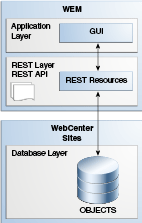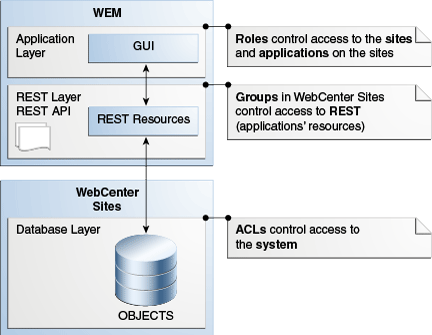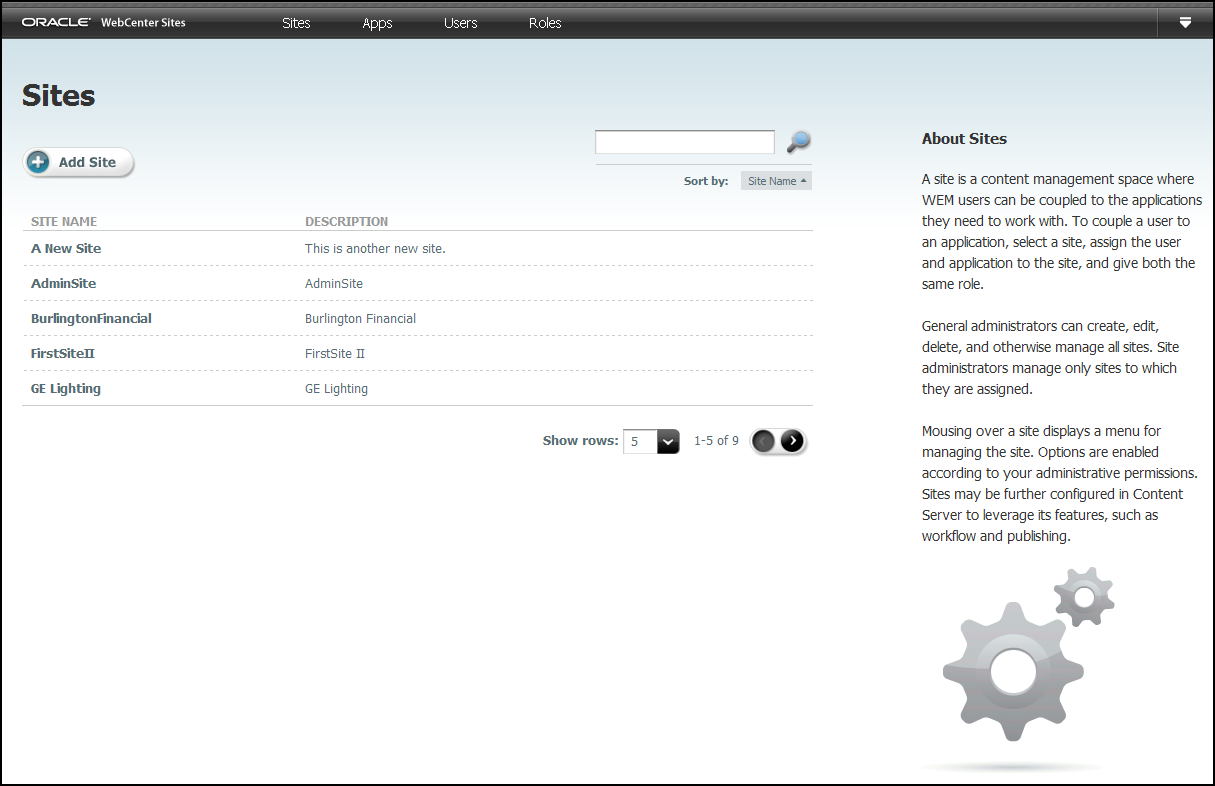56 About the Web Experience Management (WEM) Framework
With the Web Experience Management (WEM) Framework you can develop applications and integrate them with Oracle WebCenter Sites. Through its single administrative interface, WEM Admin, you can centrally manage applications and user authorization. WEM lets you implement single sign-on so the users log in only once to gain access to all applications that are allowed to them during a session.
Topics:
56.1 About the WEM Framework
The WEM Framework provides you the technology to develop and integrate applications with Oracle WebCenter Sites. The WEM Framework relies on WebCenter Sites for content management, and it’s shipped with the WebCenter Sites Representational State Transfer (REST) API.
Objects in the WebCenter Sites database, such as sites, users, and data model map to REST resources in the WEM Framework.
When implemented on the WEM Framework, applications communicate with the WebCenter Sites database through REST services. The applications appear in WEM Admin as list items on the Apps page. Administrators authorize users, which involves configuring access to the applications and their resources. To this end, the WEM Admin interface exposes authorization items (along with applications) through links on the menu bar.
Coupling the items enables applications for users.
Once the coupling is complete, users are authorized at the database, REST, and application levels.
Experienced WebCenter Sites developers will recognize that the WEM Framework extends the use of sites and roles to control access to applications. However, unlike WebCenter Sites, the WEM Admin interface does not expose the data model. The REST API does. In this respect, WEM Admin can be thought of as strictly an authorization interface, supported by the Admin interface (for configuring ACLs and groups).
Although WEM Admin is seldom used by developers, the concepts behind user authorization can come into play in application development. The next chapters describe the WEM Framework as it relates to application development and provides examples of application code.
56.2 Prerequisites for Application Development
When you’re developing an application with WEM, you code the application's logic, deploy the application, and register the application to expose it in WEM Admin interface. Administrators can manage the applicable from this interface and make it available to other users. You need to be an expert WebCenter Sites developers, and you should have a working knowledge of the technologies that are discussed for reference here.
Topics:
56.2.1 Technologies
-
Representational State Transfer (REST), used to communicate with the WebCenter Sites platform
-
Central Authentication Service (CAS), which is deployed during WebCenter Sites installation to support single sign-on for WEM
-
Java Server Pages Standard Tag Library (JSTL), Java, JavaScript, Jersey, and the Spring MVC framework, to follow the code of the Articles sample application provided with WEM
56.2.2 WebCenter Sites Interfaces, Objects, and APIs
Developers must have a working knowledge of:
-
WebCenter Sites Admin (the administrative interface)
-
WebCenter Sites basic and flex asset models
-
Asset API
-
ACLs, which protect database tables and define the types of operations that can be performed on the tables
-
Concept of sites and roles
56.2.3 Documentation
This section discusses the following documents:
Information about ACLs, sites, and roles, and their usage in WebCenter Sites is available in Working with ACLs and Roles in Administering Oracle WebCenter Sites.
56.2.4 Sample Applications and Files
-
The following sample applications are used in this part of the guide:
-
Articles, a lightweight content management application
-
SSO sample application, a small authentication application for production sites. The application is packaged as
wem-sso-api-cas-sample.war. -
Recommendations, which demonstrates the process of creating REST resources
-
-
The Customizable Single Sign-On facility is used in this section of the guide to illustrate customization of login behavior.
-
WEM Framework ships with sample files to illustrate cross-domain implementations and management of assets over REST using our API.
All sample applications and files are located in the Misc/Samples/WEM Samples folder in your WebCenter Sites installation directory.
56.2.5 Application Access
When using information in this part of the guide, or developing and testing, access the WEM Admin interface to test the results of your application registration process as follows:
-
In a Web browser, access the following URL:
http://wcs-server:wcs-port/wcs-context-root/ -
Log in as
fwadmin(or an equivalent user). -
In the page that appears, select AdminSite, then Admin (the first icon).
- The
WEM Admin Sites page appears. Registered applications are listed on the Apps page.
56.3 Getting Started
You’ll work with a sample application called Articles to understand how you can use WEM to create applications. You’ll learn about creating REST resources, single sign-on, and system security.
-
For information about the WEM Framework, see Understanding the WEM Framework and Services.
-
For a demonstration of the Articles application, see Working with the Articles Sample Application.
-
For information about the Articles application code, programmatic application registration, and cross-domain implementations, see Developing Applications with WEM Framework. An example of manual application registration is available in Registering Applications Manually in WEM Framework.
-
For information about creating REST resources, see Developing Custom REST Resources with WEM Framework.
-
For a demonstration of the SSO sample application, see Working with Single Sign-On for Production Sites.
-
For information about system security, see Using REST Resources with the WEM Framework.
-
For information about customizing the login behavior for the WEM Framework, see Introducing Customizable Single Sign-On Facility in WEM Framework.
-
For information about buffering, see Buffering in WEM Framework.




